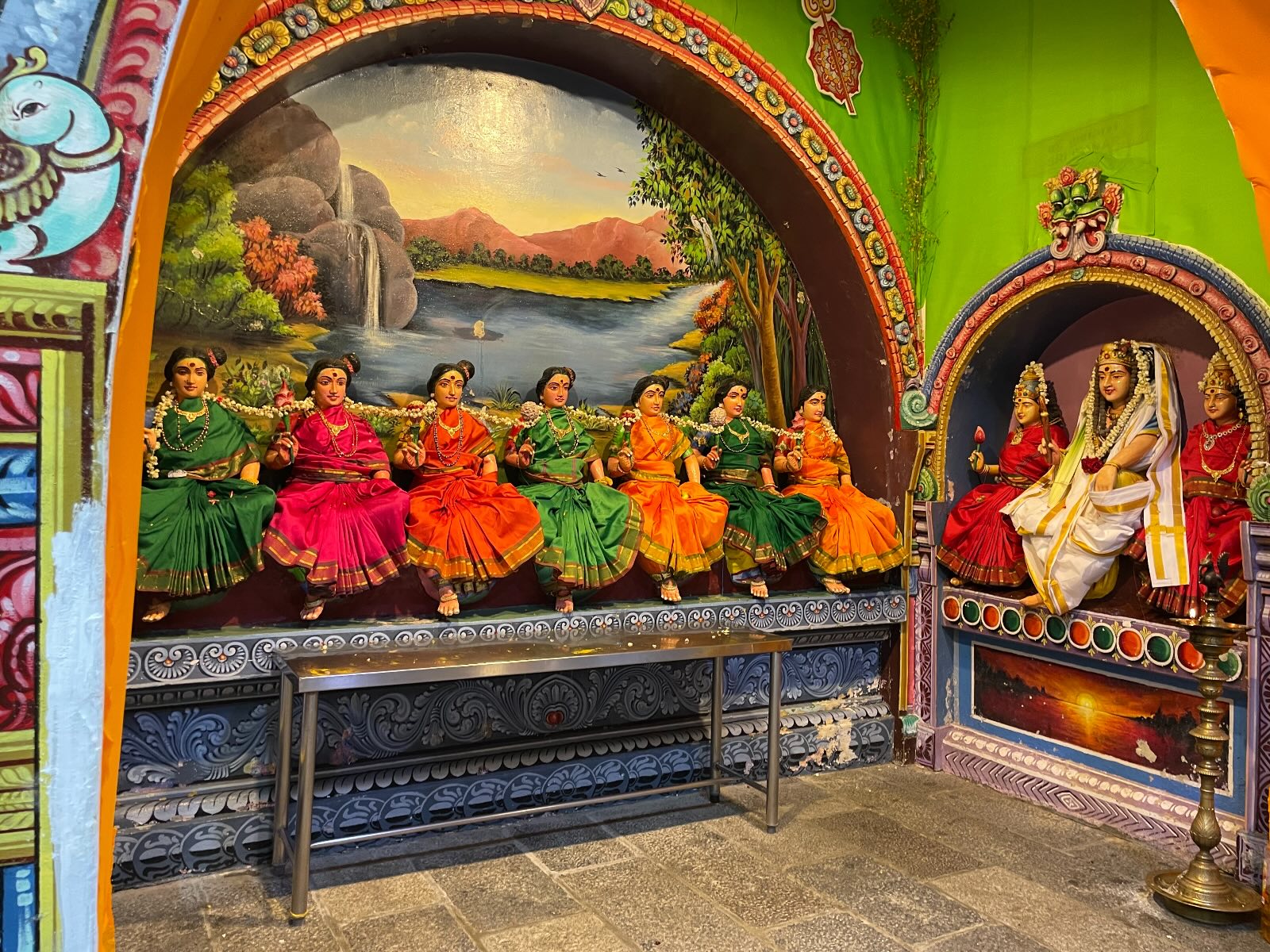Our Singapore trip was roughly about three days so we had to follow a strict itinerary, considering that we were also working remotely while on the road. But we still wanted our travel schedule to be “free and easy” so we got down to business right away and visited Chinatown. Our main goal was to visit some of the key tourist spots in Singapore, without wandering too far from our hotel near Bugis junction. We know we’ll be back so we didn’t pressure ourselves too much to avoid burnout.
We took about a five-minute ride via the MRT in Bugis to Chinatown. We alighted at the terminal, and exited from a kind of shopping complex (so sorry I couldn’t recall the name), took some photos, crossed the street and went on our way. We made our way through a few alleys, and we ended up on a wide road that had admirable street art on both walls. The street shares walls with the Sri Mariamman Temple, whose entrance can be found at 244 South Bridge road.

At the time, the temple was under renovation so it was easy to mistake that they were not letting in worshippers, tourists, or just guests in general. But we milled around a bit and saw some people leaving their shoes at the main entrance and going in, so we followed suit.

What is the history of Sri Mariamman Temple in Singapore?
According to the National Library Board of Singapore, the Sri Mariamman Temple is the oldest Hindu temple in the country. It was built by the immigrants from the Nagapattinam and Cuddalore districts of South India. Behind the establishment of the temple was Indian government clerk and businessman Naraina Pillai, who pushed for the installment of the temple. The original temple finished construction in 1827, made from wood and palm fronds.

As one of the first places of worship for Hinduism practitioners in Singapore, the Mariamman temple served as a shelter for immigrants, a mediation office, and marriage registry venue for Hindus. It was expanded beginning in 1831 and continued to be enhanced until today. The present building was said to have been built in 1862 by both Indian and Chinese immigrants.
What to Expect Inside the Sri Mariamman Temple
Upon entering the temple, there’s a donation box at the center of the entrance hall. Since entrance is free, it is encouraged for visitors to donate even just a small amount to help out in the maintenance of the premises.


There are a number of shrines and sacred relics inside the temple. Worshipers queue in front of them, taking their turns in offering a prayer. I also noticed some half-naked men inside that seemed to lead the worshippers in a sort of ritual. Apparently, these men are priests. Removing one’s shirt is also a sign of respect, and some Hindu practitioners (mostly South Indians), do this before entering a temple. There’s also the belief that the chest is where divine blessings from deities are received, which explains the reason why they are bare-chested.


I observed a bit and there are different rituals that are being performed inside. At one section of the temple, there were young priests who were attending to female worshippers, accepting flowers and incense from them. I also saw a priest who was broadcasting what I think was Hindu scripture inside one corner of the temple.


The temple was one of the most beautiful places I’ve been in Singapore. I’ve been here over a decade ago, and this was not what I remember. I’m sure the temple has undergone cosmetic changes over the years, and the colors of the statues, walls and ceilings are more vibrant now. It’s absolutely a must-visit place if you happen to find yourself in Singapore’s Chinatown.

Why Was the Sri Mariamman Temple Built in Chinatown?
There was no particular reason why it was built in Chinatown, but based on historical accounts, it was because of the town’s colonial planning and the need for the temple to have access to water.

Mr Naraina Pillai, a clerk from the British East India Company in Penang, accompanies Sir Stamford Raffles during his second visit to Singapore in 1819. The British East India Company initially allocated land for the Hindu Temple along Telok Ayer Street; however, this was not a suitable place so Colonel William Farquhar assigned an alternative plot of land to occupy near Stamford Canal but that didn’t materialize due to changes to the town’s planning. The current location along South Bridge road was provided to Pillar in 1823, and the temple was erected in 1827.

What is the most interesting feature of Sri Mariamman Hindu Temple?
The Sri Mariamman Temple was inspired by the South Indian architectural style. It features a gopuram, or an ornate monumental entrance tower, that extends high up. The gopuram represents sections of the human body. It is decorated with the likeness of Hindu deities.
What were the materials used in Building the Sri Mariamman Temple?
The original Sri Mariamman temple back in 1827 was made from wood and attap – a coastal flowering palm tree indigenous to South Asia. In 1843, the temple was reconstructed using bricks.

Frequently Asked Questions
How much is the entrance fee for the Mariamman Temple in Singapore?
Like many of the heritage and historic sites in Singapore, admission to the Sri Mariamman Temple is free. You don’t have to pay for anything, but the temple accepts donations of any amount from tourists, especially from those who are taking photographs inside.
What is the dress code for Sri Mariamman Temple Singapore?
Dress conservatively: nothing too tight, too short or skimpy. Jeans or shorts should be long enough to cover the knee. Sleeveless tops are often not allowed at temples and other religious sites in my experience (like Ayutthaya), and you will most likely be advised to cover your shoulders should you be wearing one. Just take a shawl or jacket with you.

What is Mariamman known for?
Mariamman is an ancient Hindu goddess that is associated with the Dravidian folk religion and the Indian town of Tamil Nadu. In some pre-Aryan cultures, she is believed to be Parvati, who is the wife of Lord Shiva. Mariamman is worshiped for being the mother goddess of rain, and curing diseases such as smallpox, cholera, and chicken pox. She is also worshiped as a goddess of fertility and agriculture, and personal protection from negativity and misfortune.
How do you worship Mariamman at home?
A statue of Mariamman can be placed in a puja-gham (altar) at home. It is, actually, one of the staple “goddesses” or idols that can be seen in most homes of Hindu-Tantric worshippers. Worship for Mariamman involves strict and specific rituals in honor of the goddess.

To honor Mariamman, offerings such as rice, fruits, flowers, pastries, incense, camphor and other scented herbs and food are made either at the temple or at home. It depends on the culture as to what rituals are to be performed.




Comments